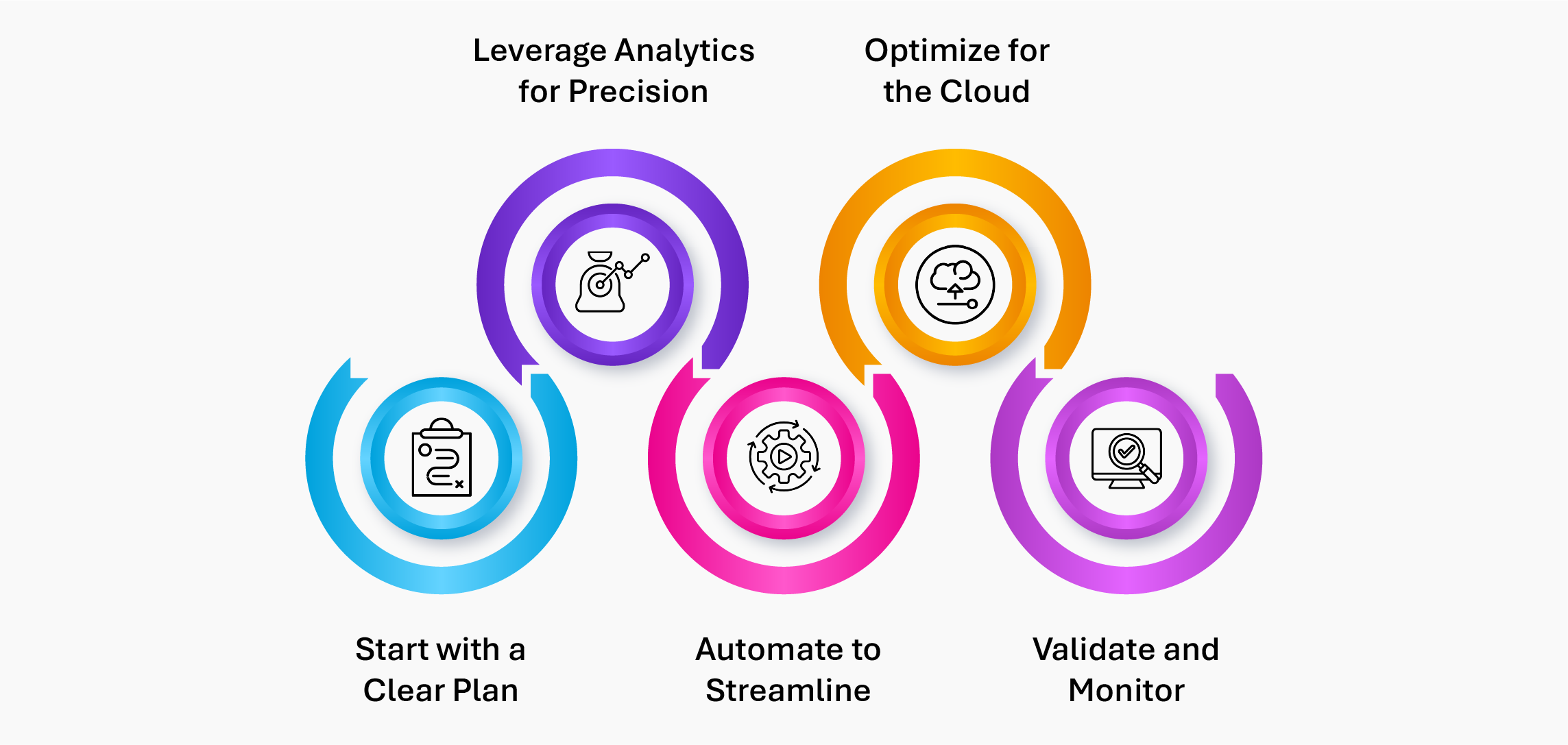In today’s digital economy, data is currency. Yet for most organizations, unstructured data—emails, videos, documents, and other formats that defy tidy categorization—remains an untapped, chaotic mess. This type of data constitutes up to 80% of enterprise information, making unstructured data migration not just a technical challenge but a strategic imperative.
As businesses race to adopt technologies like AI, ML and IoT, the migration of unstructured data has emerged as a critical enabler of innovation and efficiency. But it’s not a simple drag-and-drop operation. Enterprises must rethink their data migration process with a sharper focus on compliance, analytics, and scalability.
Importance of Unstructured Data Migration
The shift to enterprise data migration isn’t just about modernization—it’s about future-proofing operations. Legacy systems can no longer support the explosive growth of unstructured data, nor can they deliver the agility today’s enterprises demand.
Consider this: a well-executed data migration process does more than move files; it redefines how data is stored, accessed, and utilized. From cloud file migration planning to intelligent analytics, businesses gain the tools to harness their data for AI-driven insights, innovation, and strategic decision-making.
Why is unstructured data migration a game-changer?
- Driving Scalability with Cloud
With cloud data tiering, enterprises can store data intelligently, prioritizing active files while relegating archival data to lower-cost tiers. This isn’t just efficient; it’s transformative.
- Compliance as a Competitive Edge
As regulations tighten worldwide, unstructured data migration ensures compliance with laws like GDPR and CCPA. Failure to act puts businesses at risk of hefty fines and reputational damage.
- Unlocking Insights with Analytics
Post-migration, analytics for unstructured data migration offers a goldmine of insights. Imagine understanding your customers better simply by mining old emails or call logs.
The Complex Terrain of Unstructured Data Migration
The journey toward streamlined data management is rarely straightforward. Unstructured data migration presents a host of challenges that can derail even the most meticulously planned projects. Enterprises face obstacles that are not just technical but also strategic, financial, and regulatory, making the process as complex as the data itself.
- The Scale and Chaos of Unstructured Data
Unlike structured data, unstructured data exists in diverse formats and locations—emails, images, logs, and more—making it difficult to catalog and migrate efficiently. The sheer volume adds another layer of complexity, requiring robust tools to bring order to the chaos.
- Navigating Compliance Minefields
The global regulatory landscape is more demanding than ever. Moving sensitive data across borders can unintentionally breach data sovereignty laws, exposing organizations to legal penalties and reputational risks.
- The Threat of Hidden Costs
Poorly planned cloud data migration initiatives often lead to budget overruns. Unexpected expenses arise from underestimating the scope of the project, mismanaging resources, or overlooking cost-saving opportunities like cloud data tiering.
- Storage Inefficiencies That Linger
Migrating unstructured data without optimizing storage strategies can result in ballooning cloud costs. Without a focus on enhancing storage efficiency, organizations risk creating a sprawling, fragmented data landscape.
These challenges underscore the critical need for intelligent data management solutions that can transform complexity into clarity. By leveraging advanced tools and strategic planning, enterprises can navigate these obstacles with precision, ensuring their unstructured data migration efforts are not just successful but transformative.
Blueprint for Migration Success: Strategies That Work

Here are the key pillars of a winning strategy:
1. Start with a Clear Plan
Effective data migration planning strategies begin with an in-depth assessment of the existing data landscape. Organizations must inventory their unstructured data, identify its locations, and evaluate associated risks. By prioritizing datasets with the highest business value, enterprises can streamline their efforts and focus on impactful outcomes.
2. Leverage Analytics for Precision
Unlocking advanced visibility into unstructured data is crucial for success. Analytical tools powered by AI can classify, contextualize, and prioritize data, distinguishing sensitive information from low-value or redundant files. This precision reduces risks, ensures regulatory compliance, and increases overall migration efficiency.
3. Automate to Streamline
Manual processes often lead to errors and inefficiencies, making automation a non-negotiable component of modern migration strategies. Policy-driven automation can standardize workflows, enforce governance protocols, and expedite file data migration solutions, ensuring consistency and accuracy at every stage of the process.
4. Optimize for the Cloud
Effective cloud file migration planning requires alignment with comprehensive cloud data management strategies. This includes implementing cloud data tiering, which categorizes data based on usage, ensuring frequently accessed data is stored in high-performance tiers while archival data resides in cost-effective storage. This approach not only optimizes storage resources but also reduces costs.
5. Validate and Monitor
Migration doesn’t end when data is transferred; validation and continuous monitoring are critical. Rigorous testing ensures the integrity, accuracy, and accessibility of migrated data, while ongoing monitoring helps maintain system performance and prevents storage inefficiencies over time.
By following these strategies, organizations can turn the complexities of unstructured data migration into opportunities for optimization, compliance, and business growth. This approach ensures not only the seamless movement of data but also its transformation into a strategic asset.
The Technology Edge: Solutions That Drive Results
Modern enterprises navigating unstructured data migration face challenges that demand innovative, tech-driven solutions. Today’s advanced tools and softwares are transforming these migrations into streamlined, efficient processes that not only mitigate risks but also unlock new opportunities for data utilization. Here’s how cutting-edge technology is reshaping the landscape:
1. Metadata-Driven Insights for Precision
Advanced metadata analytics has become a cornerstone of effective unstructured data management. By extracting and analyzing metadata, organizations gain actionable intelligence about their data’s content, sensitivity, and usage patterns. This enables precise classification, ensures compliance with regulations, and accelerates decision-making in the migration process.
2. Policy-Driven Automation for Seamless Workflows
Automation isn’t just a convenience—it’s a necessity in today’s data migration strategies. Policy-driven workflows enforce consistent rules, eliminating manual errors and ensuring governance at scale. Automation tools can handle repetitive tasks, such as file transfers and data replication, while adhering to organizational and regulatory requirements, resulting in faster, error-free migrations.
3. Hybrid and Multi-Cloud Compatibility
As enterprises increasingly adopt hybrid and multi-cloud strategies, seamless migration across these environments is vital. The latest tools ensure that data can move effortlessly between on-premises systems, public clouds, and private infrastructures without the risk of vendor lock-in. This flexibility empowers businesses to choose the best environments for their data, optimizing performance and cost.
4. Cost Optimization Through Cloud Data Tiering
Managing storage costs is a priority for organizations dealing with large volumes of unstructured data. Cloud data tiering enables enterprises to store frequently accessed, high-value data in premium storage tiers while relegating less critical data to cost-effective options. This approach not only reduces expenses but also ensures that critical data remains readily accessible for operational and analytical purposes.
5. Enhanced Data Security and Governance
With increasing concerns around data breaches and compliance, modern migration tools integrate robust security and governance capabilities. These solutions enable data protection during migration, enforce data sovereignty requirements, and provide end-to-end visibility into unstructured data, enhancing organizational trust and regulatory alignment.
The Unstructured Data Migration Imperative
- Unstructured data is expanding at an annual rate of 55-65%, underscoring the pressing need for effective migration and management strategies.
- Gartner warns that by 2027, 60% of organizations will fail to manage unstructured data effectively, leading to inefficiencies, heightened regulatory risks, and missed innovation opportunities.
- The Data Migration Market is expected to grow from USD 10.55 billion in 2025 to USD 30.70 billion by 2034 at a CAGR of 12.59%. This growth is driven by surging data volumes, regulatory compliance needs, cloud adoption, and AI integration for enhanced migration efficiency.
Getting Started with Data Dynamics:
- Learn about Unstructured Data Management
- Schedule a demo with our team
- Read the latest blog – Unified or Siloed? Exploring the Best Strategies for Effectively Managing Your Data Resources.






